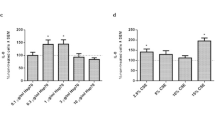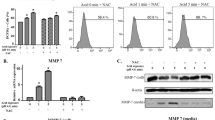Abstract
Background
Recent studies have shown that laryngopharyngeal reflux is associated with chronic rhinosinusitis. Pepsin may be a key factor involved in the injury of nasal mucosal epithelial cells, but the pathogenesis remains unclear. We are to investigate whether a mitogen-activated protein kinase (MAPK) pathway regulates heat shock protein 70 (HSP70) expression in primary cultures of human nasal epithelial cells (HNEpCs) in response to pepsin stimulation.
Methods
HSP70 protein expression levels in HNEpCs were estimated by Western blot analysis after treatment with pepsin. MAPK pathway activity levels were also evaluated to elucidate the mechanism underlying the effects of pepsin on HSP70 in HNEpCs. Inhibitors of signaling pathways were used to determine the contribution of MAPKs in HSP70 response after pepsin stimulation. Cellular apoptosis and cell viability in HNEpCs after treatment with pepsin were measured.
Results
The expression of HSP70 increased after stimulation with pepsin and decreased after the removal of pepsin. Pepsin induced activation of p38, extracellular signal-regulated kinase 1/2, and c-Jun N-terminal kinase (JNK) 1/2. Inhibition of JNK1/2 reduced HSP70 expression in HNEpCs. The apoptosis in HNEpCs at 12 h after treatment with pepsin at pH 7.0 increased significantly when compared with the control and pH 7.0 groups. Cell viability decreased following exposure to pepsin at pH 7.0.
Conclusion
Pepsin, even under neutral pH 7.0, increases the expression of HSP70 in HNEpCs by activating the JNK/MAPK signaling pathway. Increased HSP70 may be the protective mechanism when pepsin presents in the other parts of the body.





Similar content being viewed by others
References
Hastan D, Fokkens WJ, Bachert C, Newson RB, Bislimovska J, Bockelbrink A, Bousquet PJ, Brozek G, Bruno A, Dahlén SE, Forsberg B, Gunnbjörnsdóttir M, Kasper L, Krämer U, Kowalski ML, Lange B, Lundbäck B, Salagean E, Todo-Bom A, Tomassen P, Toskala E, van Drunen CM, Bousquet J, Zuberbier T, Jarvis D, Burney P (2011) Chronic rhinosinusitis in Europe—an underestimated disease. A GA2LEN study. Allergy 66(9):1216–1223
Dibaise JK, Sharma VK (2006) Does gastroesophageal reflux contribute to the development of chronic sinusitis? A review of the evidence. Dis Esophagus 19(6):419–424
Lin YH, Chang TS, Yao YC, Li YC (2015) Increased risk of chronic sinusitis in adults with gastroesophgeal reflux disease: a nationwide population-based cohort study. Medicine (Baltimore) 94(39):e1642
Sharma N, Agrawal A, Freeman J, Vela MF, Castell D (2008) An analysis of persistent symptoms in acid-suppressed patients undergoing impedance-pH monitoring. Clin Gastroenterol Hepatol 6(5):521–524
Kawamura O, Aslam M, Rittmann T, Hofmann C, Shaker R (2004) Physical and pH properties of gastroesophagopharyngeal refluxate: a 24-hour simultaneous ambulatory impedance and pH monitoring study. Am J Gastroenterol 99(6):1000–1010
Bardhan KD, Strugala V, Dettmar PW (2012) Reflux revisited: advancing the role of pepsin. Int J Otolaryngol 2012:646901
Hartl FU, Hayer-Hartl M (2002) Molecular chaperones in the cytosol: from nascent chain to folded protein. Science 295(5561):1852–1858
Dreiseidler M, Dick N, Höhfeld J (2012) Analysis of chaperone-assisted ubiquitylation. Methods Mol Biol 832(:473–487
Asea A, Kraeft SK, Kurt-Jones EA, Stevenson MA, Chen LB, Finberg RW, Koo GC, Calderwood SK (2000) HSP70 stimulates cytokine production through a CD14-dependant pathway, demonstrating its dual role as a chaperone and cytokine. Nat Med 6(4):435–442
Seki T, Yoshino KI, Tanaka S, Dohi E, Onji T, Yamamoto K, Hide I, Paulson HL, Saito N, Sakai N (2012) Establishment of a novel fluorescence-based method to evaluate chaperone-mediated autophagy in a single neuron. PLoS One 7(2):e31232
Currie RW, Karmazyn M, Kloc M, Mailer K (1988) Heat-shock response is associated with enhanced postischemic ventricular recovery. Circ Res 63(3):543–549
Sittler A, Lurz R, Lueder G, Priller J, Lehrach H, Hayer-Hartl MK, Hartl FU, Wanker EE (2001) Geldanamycin activates a heat shock response and inhibits huntingtin aggregation in a cell culture model of Huntington’s disease. Hum Mol Genet 10(12):1307–1315
Kürthy M, Mogyorósi T, Nagy K, Kukorelli T, Jednákovits A, Tálosi L, Bíró K (2002) Effect of BRX-220 against peripheral neuropathy and insulin resistance in diabetic rat models. Ann N Y Acad Sci 967:482–489
Lin D, Lin H, Xiong X (2014) Expression and role of BAG-1 in eosinophilic and non-eosinophilic chronic rhinosinusitis with nasal polyps. Inflammation 37(6):1912–1918
Min HJ, Hong SC, Yang HS, Mun SK, Lee SY (2016) Expression of CAIII and Hsp70 Is increased the mucous membrane of the posterior commissure in laryngopharyngeal reflux disease. Yonsei Med J 57(2):469–474
Wang J, Yu Z, Ren J, Xu Y, Zhang Y, Lei L, Zheng Y, Huang L, He Z (2017) Effects of pepsin A on heat shock protein 70 response in laryngopharyngeal reflux patients with chronic rhinosinusitis. Acta Otolaryngol 137(12):1253–1259
Widmann C, Gibson S, Jarpe MB, Johnson GL (1999) Mitogen-activated protein kinase: conservation of a three-kinase module from yeast to human. Physiol Rev 79(1):143–180
Rubinfeld H, Seger R (2005) The ERK cascade: a prototype of MAPK signaling. Mol Biotechnol 31(2):151–174
Bogoyevitch MA, Ngoei KR, Zhao TT, Yeap YY, Ng DC (2010) c-Jun N-terminal kinase (JNK) signaling: recent advances and challenges. Biochim Biophys Acta 1804(3):463–475
Kyriakis JM, Avruch J (2012) Mammalian MAPK signal transduction pathways activated by stress and inflammation: a 10-year update. Physiol Rev 92(2):689–737
Naor Z, Benard O, Seger R (2000) Activation of MAPK cascades by G-protein-coupled receptors: the case of gonadotropin-releasing hormone receptor. Trends Endocrinol Metab 11(3):91–99
Rangarajan A, Hong SJ, Gifford A, Weinberg RA (2004) Species- and cell type-specific requirements for cellular transformation. Cancer Cell 6(2):171–183
Volloch V, Gabai VL, Rits S, Force T, Sherman MY (2000) HSP72 can protect cells from heat-induced apoptosis by accelerating the inactivation of stress kinase JNK. Cell Stress Chaperones 5(2):139–147
Takeda K, Matsuzawa A, Nishitoh H, Tobiume K, Kishida S, Ninomiya-Tsuji J, Matsumoto K, Ichijo H (2004) Involvement of ASK1 in Ca2+-induced p38 MAP kinase activation. EMBO Rep 5(2):161–166
Matsuzawa A, Saegusa K, Noguchi T, Sadamitsu C, Nishitoh H, Nagai S, Koyasu S, Matsumoto K, Takeda K, Ichijo H (2005) ROS-dependent activation of the TRAF6-ASK1-p38 pathway is selectively required for TLR4-mediated innate immunity. Nat Immunol 6(6):587–592
Rafiee P, Theriot ME, Nelson VM, Heidemann J, Kanaa Y, Horowitz SA, Rogaczewski A, Johnson CP, Ali I, Shaker R, Binion DG (2006) Human esophageal microvascular endothelial cells respond to acidic pH stress by PI3K/AKT and p38 MAPK-regulated induction of Hsp70 and Hsp27. Am J Physiol Cell Physiol 291(5):C931–C945
Bironaite D, Brunk U, Venalis A (2013) Protective induction of Hsp70 in heat-stressed primary myoblasts: Involvement of MAPKs. J Cell Biochem 114(9):2024–2031
Johnston N, Dettmar PW, Bishwokarma B, Lively MO, Koufman JA (2007) Activity/stability of human pepsin: implications for reflux attributed laryngeal disease. Laryngoscope 117(6):1036–1039
Adhami T, Goldblum JR, Richter JE, Vaezi MF (2004) The role of gastric and duodenal agents in laryngeal injury: an experimental canine model. Am J Gastroenterol 99(11):2098–2106
Johnston N, Wells CW, Blumin JH, Toohill RJ, Merati AL (2007) Receptor-mediated uptake of pepsin by laryngeal epithelial cells. Ann Otol Rhinol Laryngol 116(12):934–938
Johnston N, Dettmar PW, Lively MO, Postma GN, Belafsky PC, Birchall M, Koufman JA (2006) Effect of pepsin on laryngeal stress protein (Sep70, Sep53, and Hsp70) response: role in laryngopharyngeal reflux disease. Ann Otol Rhinol Laryngol 115(1):47–58
Washington N, Steele RJ, Jackson SJ, Bush D, Mason J, Gill DA, Pitt K, Rawlins DA (2000) Determination of baseline human nasal pH and the effect of intranasally administered buffers. Int J Pharm 198(2):139–146
DelGaudio JM (2005) Direct nasopharyngeal reflux of gastric acid is a contributing factor in refractory chronic rhinosinusitis. Laryngoscope 115(6):946–957
Ang D, Liberek K, Skowyra D, Zylicz M, Georgopoulos C (1991) Biological role and regulation of the universally conserved heat shock proteins. J Biol Chem 266(36):24233–24236
Benjamin IJ, McMillan DR (1998) Stress (heat shock) proteins: molecular chaperones in cardiovascular biology and disease. Circ Res 83(2):117–132
Amrani M, Corbett J, Allen NJ, O’Shea J, Boateng SY, May AJ, Dunn MJ, Yacoub MH (1994) Induction of heat-shock proteins enhances myocardial and endothelial functional recovery after prolonged cardioplegic arrest. Ann Thorac Surg 57(1):157–160
Kukreja RC, Qian YZ, Okubo S, Flaherty EE (1999) Role of protein kinase C and 72 kDa heat shock protein in ischemic tolerance following heat stress in the rat heart. Mol Cell Biochem 195(1–2):123–131
Kabakov AE, Budagova KR, Bryantsev AL, Latchman DS (2003) Heat shock protein 70 or heat shock protein 27 overexpressed in human endothelial cells during posthypoxic reoxygenation can protect from delayed apoptosis. Cell Stress Chaperones 8(4):335–347
Jäättelä M, Saksela K, Saksela E (1989) Heat shock protects WEHI-164 target cells from the cytolysis by tumor necrosis factors alpha and beta. Eur J Immunol 19(8):1413–1417
Larrick JW, Wright SC (1990) Cytotoxic mechanism of tumor necrosis factor-alpha. FASEB J 4(14):3215–3223
Margulis BA, Sandler S, Eizirik DL, Welsh N, Welsh M (1991) Liposomal delivery of purified heat shock protein hsp70 into rat pancreatic islets as protection against interleukin 1 beta-induced impaired beta-cell function. Diabetes 40(11):1418–1422
Zhang HY, Zhang X, Chen X, Thomas D, Hormi-Carver K, Elder F, Spechler SJ, Souza RF (2008) Differences in activity and phosphorylation of MAPK enzymes in esophageal squamous cells of GERD patients with and without Barrett’s esophagus. Am J Physiol Gastrointest Liver Physiol 295(3):G470–G478
Zhang L, Liu G, Han X, Liu J, Li GX, Zou DW, Li ZS (2015) Inhibition of p38 MAPK activation attenuates esophageal mucosal damage in a chronic model of reflux esophagitis. Neurogastroenterol Motil 27(11):1648–1656
Uehara T, Kaneko M, Tanaka S, Okuma Y, Nomura Y (1999) Possible involvement of p38 MAP kinase in HSP70 expression induced by hypoxia in rat primary astrocytes. Brain Res 823(1–2):226–230
Sheikh-Hamad D, Di MJ, Suki WN, Safirstein R, Watts BA, Rouse D (1998) p38 kinase activity is essential for osmotic induction of mRNAs for HSP70 and transporter for organic solute betaine in Madin-Darby canine kidney cells. J Biol Chem 273(3):1832–1837
Funding
This study was funded by the International Scientific and Technological Cooperation Projects of Sichuan Province (no. 2016HH0064); Fundamental Research Funds for the Central Universities (No. 2012017yjsy118).
Author information
Authors and Affiliations
Corresponding author
Ethics declarations
Conflict of interest
The authors declare that they have no conflicts of interest.
Ethical approval
This article does not contain any studies with human participants or animals performed by any of the authors.
Informed consent
None.
Rights and permissions
About this article
Cite this article
Wang, J., Zhao, Y., Ren, J. et al. Heat shock protein 70 is induced by pepsin via MAPK signaling in human nasal epithelial cells. Eur Arch Otorhinolaryngol 276, 767–774 (2019). https://doi.org/10.1007/s00405-018-5254-3
Received:
Accepted:
Published:
Issue Date:
DOI: https://doi.org/10.1007/s00405-018-5254-3




